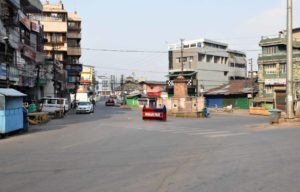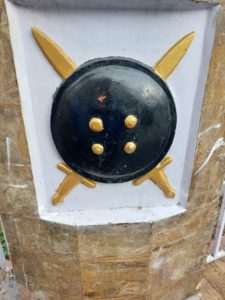By Priyan R Naik
 Always fascinated by memorials, I was keen on seeing the Motphran monument erected to commemorate the sacrifice of the Khasis during World War I. Located in Iewduh (Bara Bazaar), Shillong’s largest market, it was built by the British and is an important tourist terminus in Meghalaya. Translated, it literally means ‘Stone of France’. The British had originally named it ‘Mot France’ or the ‘Monument of France, but since the locals found it difficult to pronounce it, it came to be known as Motphran. It was dedicated to 67 porters of the 26th Khasi Labour Corps who had carried arms, ammunition and essential items for British soldiers serving in France, during the First World War, none of whom could return home, as they died during the war. The memorial engraved with a Latin inscription a translation of which reads ‘It is sweet to die for one’s country’ was meant to honour them in death.
Always fascinated by memorials, I was keen on seeing the Motphran monument erected to commemorate the sacrifice of the Khasis during World War I. Located in Iewduh (Bara Bazaar), Shillong’s largest market, it was built by the British and is an important tourist terminus in Meghalaya. Translated, it literally means ‘Stone of France’. The British had originally named it ‘Mot France’ or the ‘Monument of France, but since the locals found it difficult to pronounce it, it came to be known as Motphran. It was dedicated to 67 porters of the 26th Khasi Labour Corps who had carried arms, ammunition and essential items for British soldiers serving in France, during the First World War, none of whom could return home, as they died during the war. The memorial engraved with a Latin inscription a translation of which reads ‘It is sweet to die for one’s country’ was meant to honour them in death.
I set off from Police Bazaar, an umbrella in hand for Shillong’s unpredictable rains had decided to make its appearance much to my discomfort. Alongside there was a sea of people, all with their umbrellas open. The colorful umbrellas were a sight to behold, only everyone walked on the crowded narrow pathway behaving as if theirs was the only umbrella that opened out. Chaos reigned, as I alternately had to duck below or raise my umbrella high for people with their umbrellas to cross me on the narrow footpath and stairways that would take me to the monument.
 Arriving at a busy traffic junction soon enough, chock-a-block with buses and taxis making loud noises as they honked away in unison, I could make out a long over-looked, nondescript piece of public property with a mass of hawkers surrounding it, totally bereft of any knowledge about its historical background. The monument seemed more like an irritant amidst a bustling spot caught in traffic gridlock appearing to hamper smooth traffic movement. I could vaguely make out newly fabricated iron grills with Khasi traditional motifs, recently painted with a fresh coat of paint. Surrounded by mounds of litter, the area did have a few plants and saplings here and there signifying efforts to keep the environment clean and beautiful.
Arriving at a busy traffic junction soon enough, chock-a-block with buses and taxis making loud noises as they honked away in unison, I could make out a long over-looked, nondescript piece of public property with a mass of hawkers surrounding it, totally bereft of any knowledge about its historical background. The monument seemed more like an irritant amidst a bustling spot caught in traffic gridlock appearing to hamper smooth traffic movement. I could vaguely make out newly fabricated iron grills with Khasi traditional motifs, recently painted with a fresh coat of paint. Surrounded by mounds of litter, the area did have a few plants and saplings here and there signifying efforts to keep the environment clean and beautiful.
Amidst the chaos and confusion of honking vehicles, I took a few photographs and spent a while thinking of the dedication and sense of duty of these men who were taken to the theatres of World War I that broke out in 1914 in Europe between the Allied powers and Germany, till the 1919 Treaty of Versailles took effect and officially brought the war to a close. I could make out some of their names inscribed on the monument: Jir Wallang, Pahoh Thabah, Muluk Nongrum…..
My hometown, Bengaluru, too has a war memorial dedicated to the 1st Madras Pioneers regiment that fought World War I. From a geographical standpoint, it is strategically located in the heart of Bengaluru’s busiest street, Brigade Road. However, just like Motphran, it has become invisible among glitzy shopping centres, watering holes and food joints that have stolen the thunder of a historical edifice. It seems to have become a forgotten chapter in history, left without a decent approach path and barricaded by a rickety wrought-iron fence.
 Both these monuments commemorating loss of natives during World War I, located in the heart of the city welcome thousands of footfalls everyday, unfortunately locals seem oblivious to them and remain far from appreciating its importance and rarely ever, stop by them. Sadly, these monuments are treated as if they are just nondescript urban statuettes!
Both these monuments commemorating loss of natives during World War I, located in the heart of the city welcome thousands of footfalls everyday, unfortunately locals seem oblivious to them and remain far from appreciating its importance and rarely ever, stop by them. Sadly, these monuments are treated as if they are just nondescript urban statuettes!
*************
Priyan R Naik is a columnist and a freelance journalist living in Bengaluru, India. His works appear in the Deccan Herald, Ceylon Today of Colombo, Hindustan Times, The Hindu, Hindu Business Line, Times of India, Navhind Times, and Daily Star of Dhaka.



